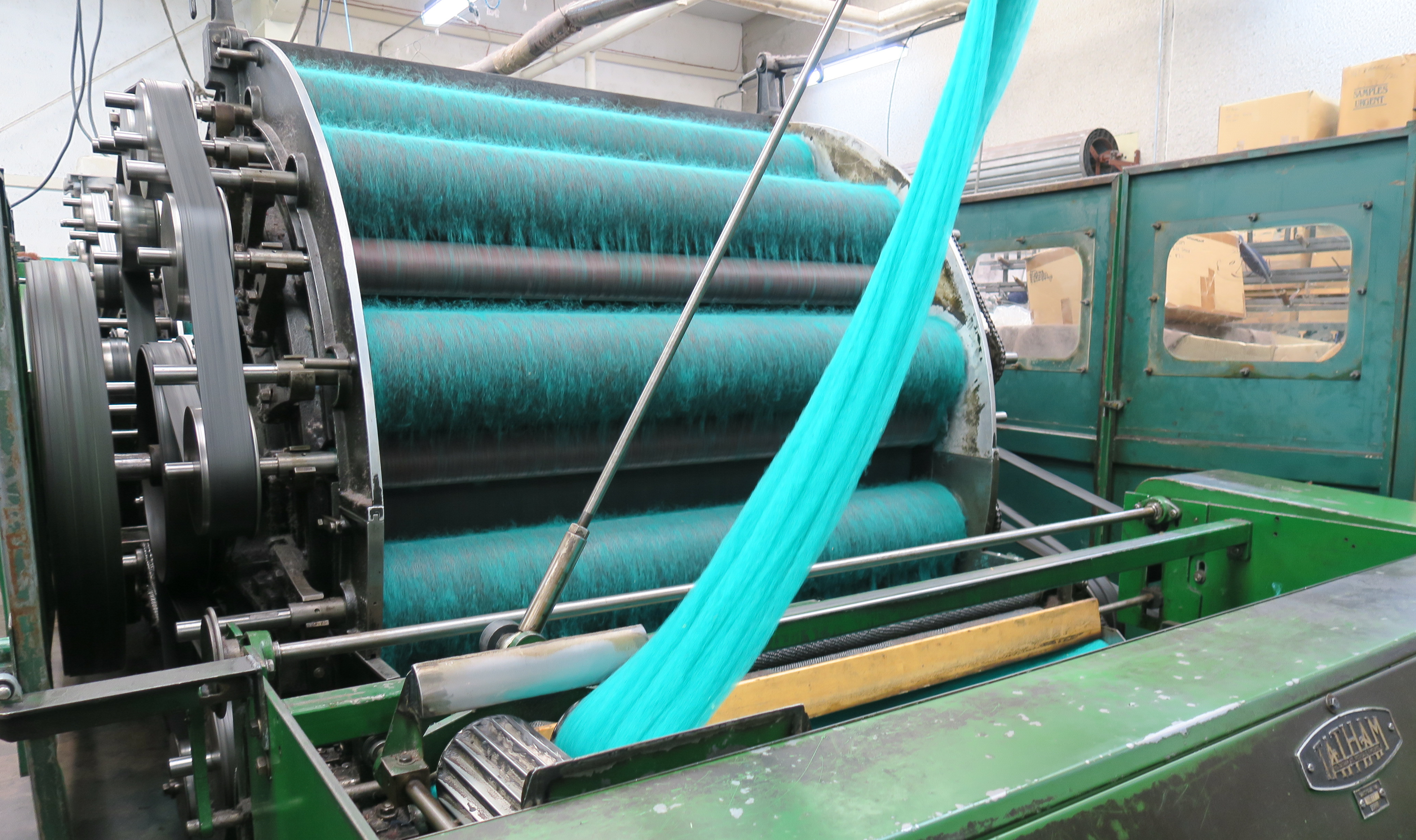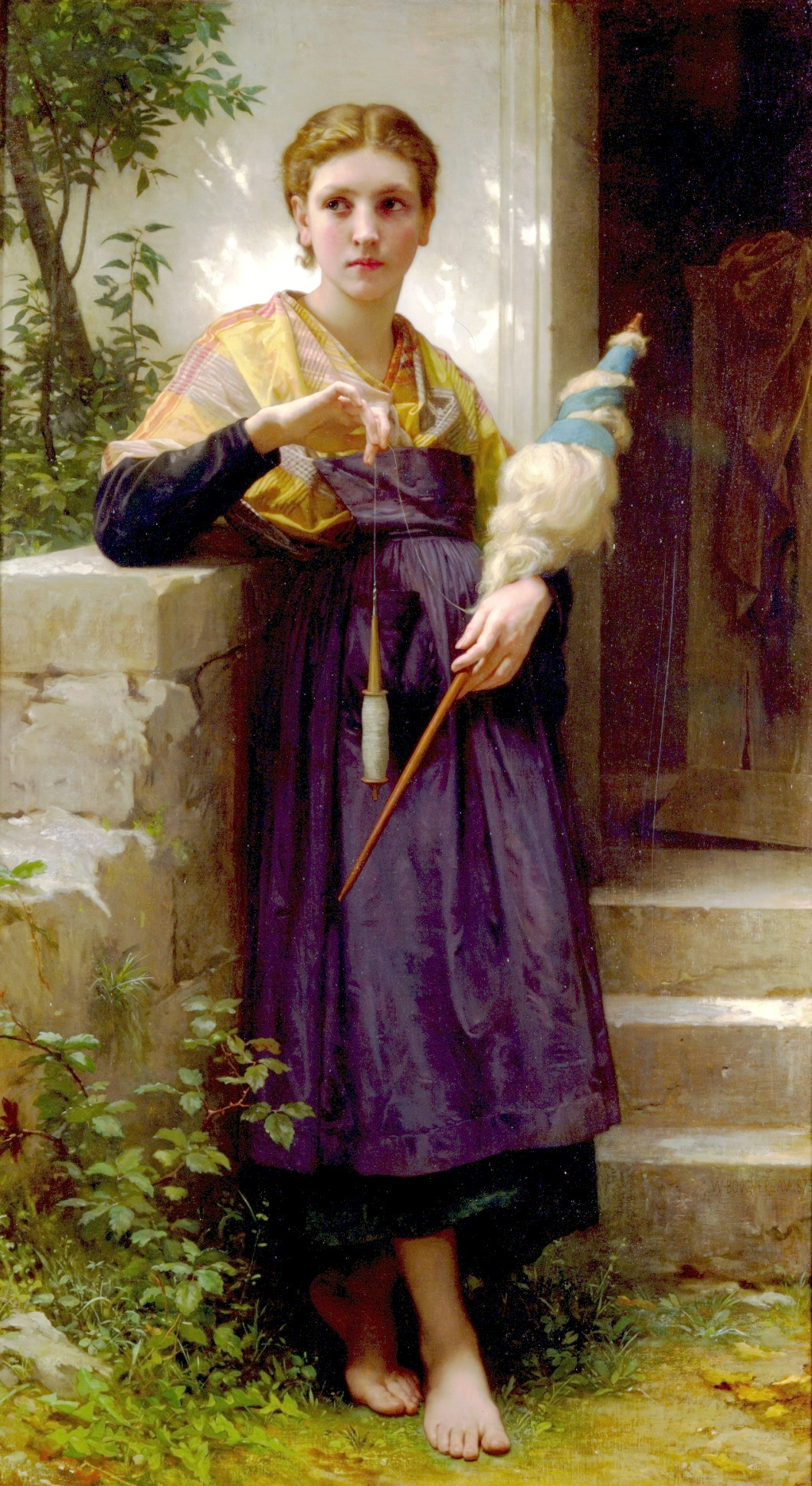|
Roving (other)
A roving is a long and narrow bundle of fiber. Rovings are produced during the process of making spun yarn from wool fleece, raw cotton, or other fibres. Their main use is as fibre prepared for spinning, but they may also be used for specialised kinds of knitting or other textile arts. After carding, the fibres lie roughly parallel in smooth bundles. These are drawn out, by hand or machine, and slightly twisted to form lengths suitable for thread spinning. These unspun strands of fibre are the rovings. Roving can also mean a roll of these strands, the strands in general (as a mass noun), or the process of creating them. Because it is carded, the fibres are less parallel than wool top Topmaking mills make ''wool top'', a semi-processed product from raw wool Wool is the textile fiber obtained from sheep and other mammals, especially goats, rabbits, and camelids. The term may also refer to inorganic materials, such as ... (which is combed) and are not of uniform lengt ... [...More Info...] [...Related Items...] OR: [Wikipedia] [Google] [Baidu] |
Spinning (textiles)
Spinning is a twisting technique to form yarn from fibers. The fiber intended is drawn out, twisted, and wound onto a bobbin. A few popular fibers that are spun into yarn other than cotton, which is the most popular, are viscose (the most common form of rayon), animal fibers such as wool, and synthetic polyester. Originally done by hand using a spindle whorl, starting in the 500s AD the spinning wheel became the predominant spinning tool across Asia and Europe. The spinning jenny and spinning mule, invented in the late 1700s, made mechanical spinning far more efficient than spinning by hand, and especially made cotton manufacturing one of the most important industries of the Industrial Revolution. Process The yarn issuing from the drafting rollers passes through a thread-guide, round a Ring spinning#How it works, traveller that is free to rotate around a ring, and then onto a tube or bobbin, which is carried on to a Spindle (textiles), spindle, the axis of which passes through a ... [...More Info...] [...Related Items...] OR: [Wikipedia] [Google] [Baidu] |
Wool
Wool is the textile fiber obtained from sheep and other mammals, especially goats, rabbits, and camelids. The term may also refer to inorganic materials, such as mineral wool and glass wool, that have some properties similar to animal wool. As an animal fiber, wool consists of protein together with a small percentage of lipids. This makes it chemically quite distinct from cotton and other plant fibers, which are mainly cellulose. Characteristics Wool is produced by follicles which are small cells located in the skin. These follicles are located in the upper layer of the skin called the epidermis and push down into the second skin layer called the dermis as the wool fibers grow. Follicles can be classed as either primary or secondary follicles. Primary follicles produce three types of fiber: kemp, medullated fibers, and true wool fibers. Secondary follicles only produce true wool fibers. Medullated fibers share nearly identical characteristics to hair and are long but ... [...More Info...] [...Related Items...] OR: [Wikipedia] [Google] [Baidu] |
Carding
In Textile manufacturing, textile production, carding is a mechanical process that disentangles, cleans and intermixes fibres to produce a continuous web or sliver (textiles), sliver suitable for subsequent processing. This is achieved by passing the fibres between differentially moving surfaces covered with "card clothing", a firm flexible material embedded with metal pins. It breaks up locks and unorganised clumps of fibre and then aligns the individual fibres to be parallel with each other. In preparing wool fibre for Spinning (textiles), spinning, carding is the step that comes after teasing. The word is derived from the Latin meaning thistle or Dipsacus, teasel, as dried vegetable teasels were first used to comb the raw wool before technological advances led to the use of machines. Overview The ordered fibres can then be passed on after carding to other processes that are specific to the desired end use of the fibre: Cotton mill, Cotton, Batting (material), batting, felt, ... [...More Info...] [...Related Items...] OR: [Wikipedia] [Google] [Baidu] |
Hand Spinning
Spinning is an ancient textile art in which plant, animal or synthetic fibres are drawn out and twisted together to form yarn. For thousands of years, fibre was spun by hand using simple tools, the spindle and distaff. After the introduction of the spinning wheel in the 13th century, the output of individual spinners increased dramatically. Mass production later arose in the 18th century with the beginnings of the Industrial Revolution. Hand-spinning remains a popular handicraft. Characteristics of spun yarn vary according to the material used, fibre length and alignment, quantity of fibre used, and degree of twist. History The origins of spinning fibre to make string or yarn are lost in time, but archaeological evidence in the form of representation of string skirts has been dated to the Upper Paleolithic era some 20,000 years ago. There has also been recent discovery of plied cord spun by Neanderthals and dating back 41,000-52,000 years. In the earliest type of spinning, t ... [...More Info...] [...Related Items...] OR: [Wikipedia] [Google] [Baidu] |
Mass Noun
In linguistics, a mass noun, uncountable noun, non-count noun, uncount noun, or just uncountable, is a noun with the syntactic property that any quantity of it is treated as an undifferentiated unit, rather than as something with discrete elements. Uncountable nouns are distinguished from count nouns. Given that different languages have different grammatical features, the actual test for which nouns are mass nouns may vary between languages. In English, mass nouns are characterized by the impossibility of being directly modified by a numeral without specifying a unit of measurement and by the impossibility of being combined with an indefinite article (''a'' or ''an''). Thus, the mass noun "water" is quantified as "20 litres of water" while the count noun "chair" is quantified as "20 chairs". However, both mass and count nouns can be quantified in relative terms without unit specification (e.g., "so much water", "so many chairs", though note the different quantifiers "much" a ... [...More Info...] [...Related Items...] OR: [Wikipedia] [Google] [Baidu] |
Wool Top
Topmaking mills make ''wool top'', a semi-processed product from raw wool Wool is the textile fiber obtained from sheep and other mammals, especially goats, rabbits, and camelids. The term may also refer to inorganic materials, such as mineral wool and glass wool, that have some properties similar to animal w .... The process requires that the wool be scoured (washed) and combed and sorted. The longer fibers resulting from the process are called tops, and are in a form ready for spinning. To be closer to customers, some of the industry has moved from Australia, Europe and the US to China. Many American and British companies produce high quality wool top in from sheep wool and fiber; most work with the fleece from cleaning it to hand dying. A topmaker is an old term for a person engaged in the process. Spinning Wool industry {{textile-stub ... [...More Info...] [...Related Items...] OR: [Wikipedia] [Google] [Baidu] |
Sliver (textiles)
A sliver () is a long bundle of fibre that is generally used to spin yarn. A sliver is created by carding or combing the fibre, which is then drawn into long strips where the fibre is parallel. When sliver is drawn further and given a slight twist, it becomes roving. International Textile Center textiles differ from woolen
Woolen (American English) or woollen (Commonwealth English) is a type of yarn made from carded wool. Woolen yarn is soft, light, stretchy, and full of air. It is thus a good insulator, and makes a good knitting yarn. Woolen yarn is ...
[...More Info...] [...Related Items...] OR: [Wikipedia] [Google] [Baidu] |
Lopi (knitting)
Lopi () is knitting wool made from the fleece of Icelandic sheep. The fleece is made up of two layers, each with a different kind of wool. The wet-resistant outer coat contains long, coarse fibres, while the insulating layer beneath consists of soft, short fibres. These are processed together to create lopi roving A roving is a long and narrow bundle of fiber. Rovings are produced during the process of making spun yarn from wool fleece, raw cotton, or other fibres. Their main use is as fibre prepared for spinning, but they may also be used for specialise ... and yarn. History The machine- carded roving is produced in disc-shaped rolls. The original unspun lopi was first used for knitting c.1920s. More recently, lightly spun lopi yarn in different thicknesses has become available. Most wool produced in Iceland is processed by Ístex, the Icelandic Textile Company. They manufacture 7 types of spun lopi yarn and also unspun lopi, all in a variety of natural fleece shades and i ... [...More Info...] [...Related Items...] OR: [Wikipedia] [Google] [Baidu] |
Thrum (textiles)
Thrumming is a technique in which small pieces of wool or yarn (thrums) are pulled through fabric to create a wooly layer. The term ''thrum'' originally referred specifically to worthless pieces of Warp and weft, warp thread which remained after weaving a piece of fabric using a loom, though its meaning has since broadened to include any small pieces of wool or thread which are used in a similar way. Applications Thrum caps A thrum cap (or thrummed cap) consisted of a canvas base in the shape of an inverted flower pot, with woolen thrums pushed through to create a shaggy exterior. Such caps were worn by sailors in the Tudor period, and were commonly dyed blue or brown. They continued to be in use into the seventeenth century. Stuffed mittens Stuffed mittens (also known in Newfoundland and Labrador, where they are traditionally made, as "thrummed mittens") are thrummed with tufts of fleece to create a warm, fluffy interior which gradually felts with use. The same technique may als ... [...More Info...] [...Related Items...] OR: [Wikipedia] [Google] [Baidu] |
Spinning
Spin or spinning most often refers to: * Spin (physics) or particle spin, a fundamental property of elementary particles * Spin quantum number, a number which defines the value of a particle's spin * Spinning (textiles), the creation of yarn or thread by twisting fibers together, traditionally by hand spinning * Spin (geometry), the rotation of an object around an internal axis * Spin (propaganda), an intentionally biased portrayal of something Spin, spinning or spinnin may also refer to: Physics and mathematics * Spin group, Spin(''n''), a particular double cover of the special orthogonal group SO(''n'') ** the corresponding spin algebra, \mathfrak(n) * Spin tensor, a tensor quantity for describing spinning motion in special relativity and general relativity * Spin (aerodynamics), autorotation of an aerodynamically stalled aeroplane * SPIN bibliographic database, an indexing and abstracting service focusing on physics research Textile arts * Spinning (polymers), a process ... [...More Info...] [...Related Items...] OR: [Wikipedia] [Google] [Baidu] |






